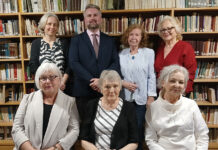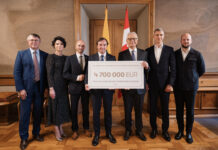
One in a series of articles about the history of the Grand Duchy of Lithuania, a project by the University of Vilnius called “Orbis Lituaniae”. The website www.ldkistorija.lt provides hundreds of stories about life, culture and politics during the era of the Grand Duchy.
The Grand Duchy of Lithuania had a veritable artistic explosion in the 17th century, with the construction of a number of world-class Baroque churches and palaces. Many of those were designed by Italian architects who came from one small region, Ticino.
Prior to the late 16th century, few Lithuanian monarchs and nobles took much interest in projecting power through grand architecture. In the mid-16th century, a number of artists came to rebuild the Grand Duke’s Palace in Vilnius, invited by Sigismund Augustus. However, few works from this time survive (one is the tombstone of Paweł Holszański, or Paulius Alšėniškis).
The situation changed in the late 16th and early 17th centuries. Prince Mikołaj Krzysztof Radziwiłł (Mikalojus Kristupas Radvila Našlaitėlis) nicknamed “the Orphan” was a Polish–Lithuanian nobleman and chancellor of the Grand Duchy, rebuilt the town of Nyasvizh (now in Belarus), constructed a comfortable residence for himself, and founded several monasteries. He invited several talented architects, sculptors and painters to participate in the work.
After a fire in Vilnius in 1610 ravished the Grand Dukes’ Palace, Italian artists also worked on rebuilding it. They also built the Royal Chapel of St. Casimir in Vilnius Cathedral.
The best artists of the times were engaged for these projects by rulers Sigismund Vasa and Władisław Vasa.
The first artists to come from the Ticino area by Lake Lugano appeared in the Grand Duchy of Lithuania at the end of the 16th century. One of them was the Jesuit architect Giovanni Maria Bernardoni, who came to build the Jesuit house and church for Prince Radvila in Nyasvizh.
The prince made sure that Bernardoni, who also came from the town of Lugano, stay longer. In the 13 years that the Jesuit architect worked in Nyasvizh, he built the Church of Corpus Christi, the first Baroque church in the Grand Duchy (or he helped design it), and ten more churches and monasteries for the prince.
The brothers Jacopo and Constante Tencalla, who worked in Vilnius in the 1620s and 1630s, were just as instrumental in popularizing Baroque artistic forms. They came to build and decorate the Royal Chapel of St Casimir in Vilnius Cathedral, and later carried out other orders for nobles of the Grand Duchy. Whereas Jacopo worked more on individual commissions in Lithuania, Poland and Austria, Constante worked only on the palaces of the rulers of the Polish-Lithuanian Commonwealth until the end of his life in 1646.

His uncle, Matteo Castelli, who was then Sigismund Vasa’s main architect (he was commissioned to design St Casimir’s Chapel), invited his brother from the small town of Bisones in the Ticino area. Relations, acquaintances and neighbours were drawn into the market for works of art, and later travelled to the Grand Duchy. Castelli, coming from the Ticino area, was probably the first architect in Poland and Lithuania who was also a famous architect in Italy. In Rome, he worked with Carlo Maderno, the pioneer of Baroque architecture, who also came from the area around Lake Lugano. The architects Giacomo della Porta (d. 1602), Domenico Fontana (d. 1607) and Francesco Borromini (d. 1667), who contributed significantly to the development of Roman Baroque architecture, originated there as well.
Italian architects would often come with entire families. In the mid-17th century, the architect Isidoro Affaitatti came to Poland and was engaged at the royal court. Soon, his sister’s sons, the architects Carlo and Francesco Ceroni, came to work at Pažaislis, as did his niece’s husband Pietro Puttini and his brother Carlo Puttini from Albogasio. At the initiative of the latter, Giovanni Battista Merli, from a neighbouring small town, was invited to decorate the church at Pažaislis with stucco moulding.
At almost the same time, Giovanni Pietro Perti and Giovanni Maria Galli came from Ticino and spent eight years making stucco decorations for the Church of Sts. Peter and Paul in Vilnius.


All these artists and architects were at the top of their profession and could find work in any city across Europe, as some did after finishing work in the Grand Duchy. They all contributed to the development of Baroque art.
The geography of the shores of Lake Lugano, from where they all came, is interesting. Most of it was part of the canton of Ticino in Switzerland, the rest was part of Lombardy in Italy and bordered Lake Como and the Como area (the newcomers were sometimes called komaskai).
The area around Lake Lugano is forested and rocky, unsuitable for farming, and difficult to reach. The towns are small even today, with populations rarely exceeding a thousand people.
In the 17th century, the numbered in the hundreds, thus the fact that many accomplished artists, architects and sculptors came from such a small location is remarkable.
Adapted from Orbis Lituaniae project by Vilnius University



























